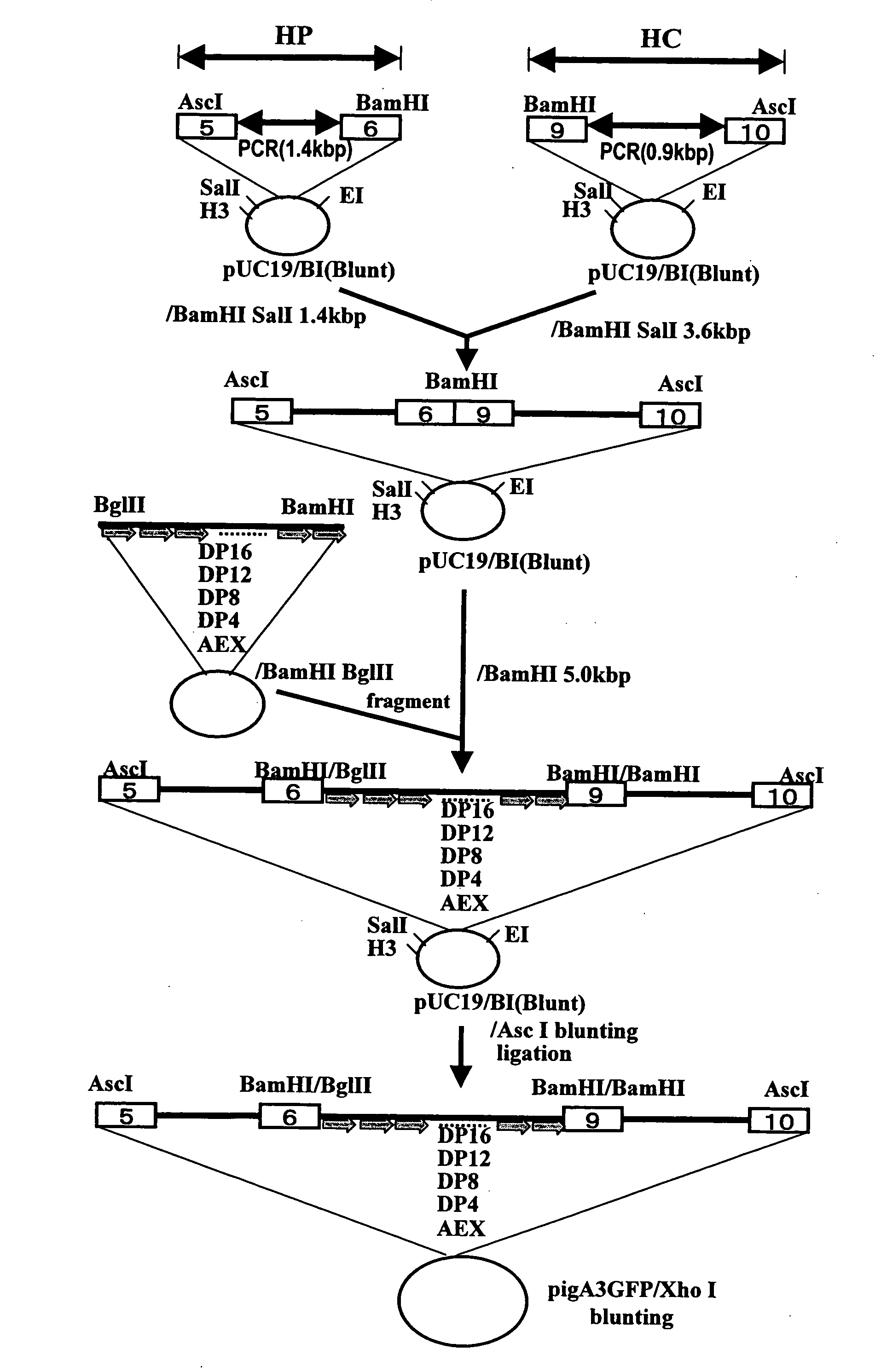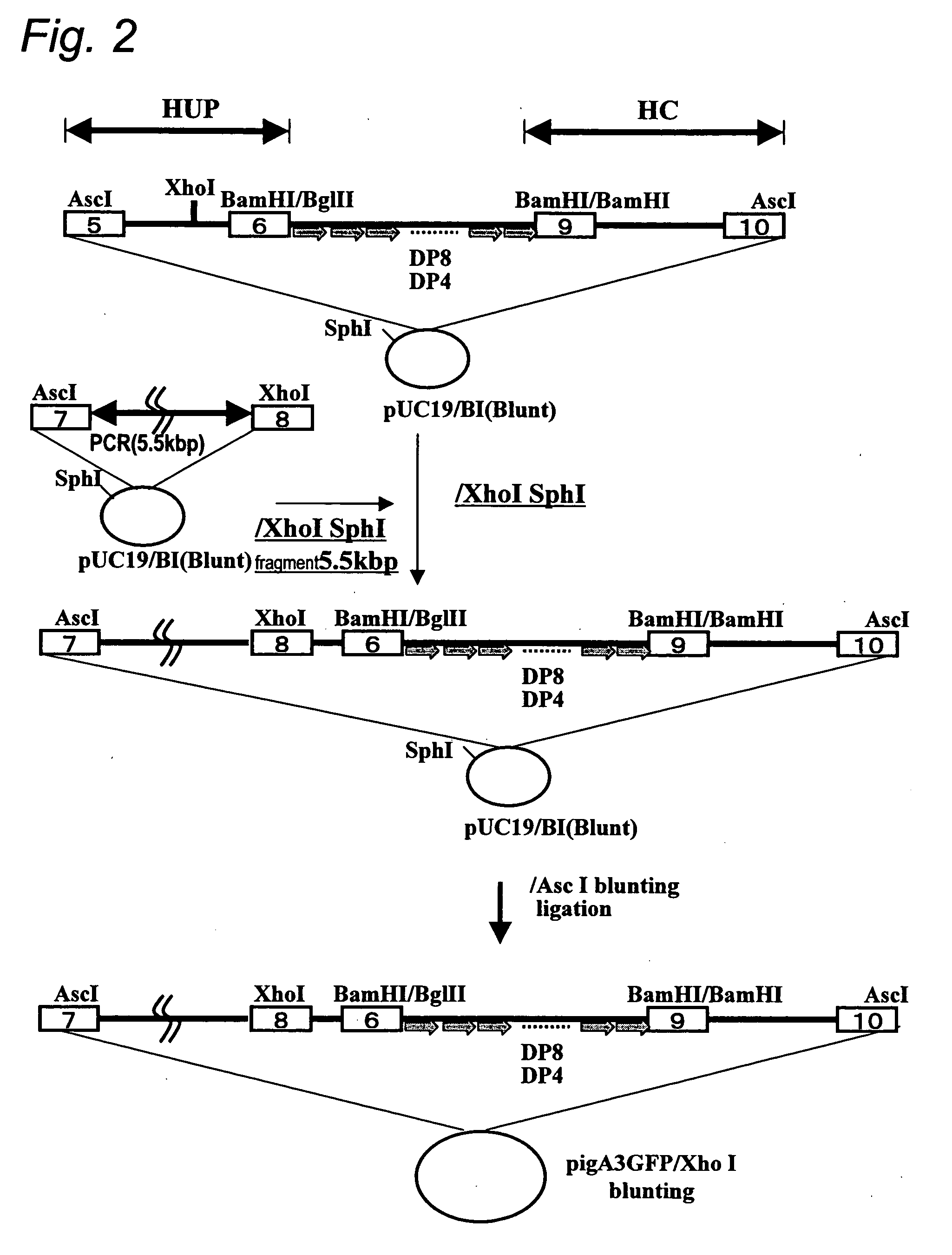Silk Thread Containing Spider Thread Protein and Silk Worm Producing the Silk Thread
a technology of silk worm and spider thread, which is applied in the field of silk thread, can solve the problems of difficult solubilization and purification of natural spider thread, difficult to breed spiders in groups, and difficult to achieve the production of large amounts of silk worm thread directly from spiders, etc., and achieves excellent physical properties of textiles, enhanced strength, elasticity and/or toughness, and enhanced strength
- Summary
- Abstract
- Description
- Claims
- Application Information
AI Technical Summary
Benefits of technology
Problems solved by technology
Method used
Image
Examples
example 1
Preparation of Bombyx mori Genomic DNA
[0099]Fifth-instar-three-day-old silkworms were dissected and the posterior silk gland tissue was removed. After rinsing with 1×SSC, 200 μl of DNA extraction buffer (50 mM Tris-HCl pH 8.0, 1 mM EDTA pH 8.0, 100 mM NaCl) was added. Proteinase K (final concentration: 200 μg / ml) was added and the tissue was thoroughly crushed with a grinder, after which 350 μl of DNA extraction buffer and 60 μl of 10% SDS were added prior to mixing. The mixture was incubated at 50° C. for 2 hours. After then adding 500 μl of Tris-HCl equilibrated phenol (pH 8.0) and stirring for 10 minutes, centrifugation was performed at 10,000 rpm for 5 minutes at 4° C. and the supernatant was collected. The supernatant was treated with phenol / chloroform and the genomic DNA was ethanol precipitated. It was then dissolved and diluted to 100 μg / ml with RNase-added sterilized water to prepare a genomic DNA solution.
example 2
Gene Preparation
[0100]The gene used may be obtained by PCR with end primers prepared utilizing known sequences and a suitable DNA source used as template. Restriction endonuclease cleavage sites are attached to the ends of the primers for subsequent gene manipulation.
[0101]The fibroin H chain promoter•fibroin H chain gene first exon•first intron•second exon region (GenBank Accession No. AF226688, nucleotides 62118-63513: hereinafter referred to as HP region) is obtained by PCR using Bombyx mori genomic DNA as template and two different primers, Primer 5 (SEQ ID NO: 5) and Primer 6 (SEQ ID NO: 6).
[0102]The fibroin H chain upstream promoter•fibroin H chain gene first exon•first intron region (GenBank Accession No. AF226688, nucleotides 57444-62927: hereinafter referred to as HUP region) is obtained by PCR using Bombyx mori genomic DNA as template and two different primers, Primer 7 (SEQ ID NO: 7) and Primer 8 (SEQ ID NO: 8).
[0103]The fibroin H chain C-terminal region gene•fibroin H ch...
example 3
Preparation of Gene Transfer Plasmid
[0109]The gene transfer plasmid used was pigA3GFP (Nature Biotechnology 18, 81-84, 2000). Specifically, pigA3GFP is a vector obtained by removing the transposase-coding region from plasmid p3E1.2 disclosed in U.S. Pat. No. 6,218,185, and inserting at that section the A3 promoter (GenBank Accession No. U49854, nucleotides 1764-2595) and pEGFP-N1 vector (Clontech)-derived GFP and SV40 polyA addition sequence (GenBank Accession No. U55762, nucleotides 659-2578); this vector may be dispensed from the National Institute of Agrobiological Sciences. The XhoI site upstream from the A3 promoter was blunted and the gene designed to produce silk thread containing spider thread protein was inserted.
[0110]The structures of the genes designed to produce silk thread containing spider thread protein in this example were HP•DP16,12,8,4•HC and HP•AEX•HC, as well as HUP•DP8,4•HC.
[0111]The method is described specifically below.
[0112]FIG. 1 shows a construction strat...
PUM
| Property | Measurement | Unit |
|---|---|---|
| Protein content | aaaaa | aaaaa |
| Protein content | aaaaa | aaaaa |
| Protein content | aaaaa | aaaaa |
Abstract
Description
Claims
Application Information
 Login to View More
Login to View More - R&D
- Intellectual Property
- Life Sciences
- Materials
- Tech Scout
- Unparalleled Data Quality
- Higher Quality Content
- 60% Fewer Hallucinations
Browse by: Latest US Patents, China's latest patents, Technical Efficacy Thesaurus, Application Domain, Technology Topic, Popular Technical Reports.
© 2025 PatSnap. All rights reserved.Legal|Privacy policy|Modern Slavery Act Transparency Statement|Sitemap|About US| Contact US: help@patsnap.com



